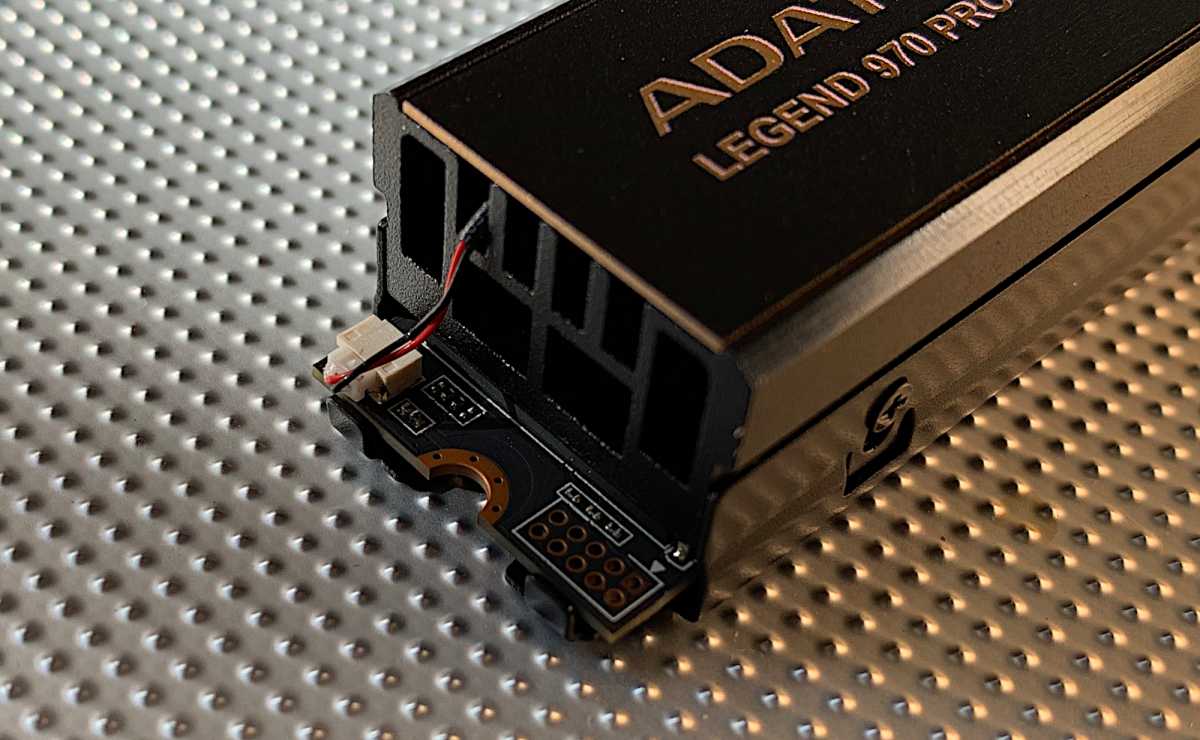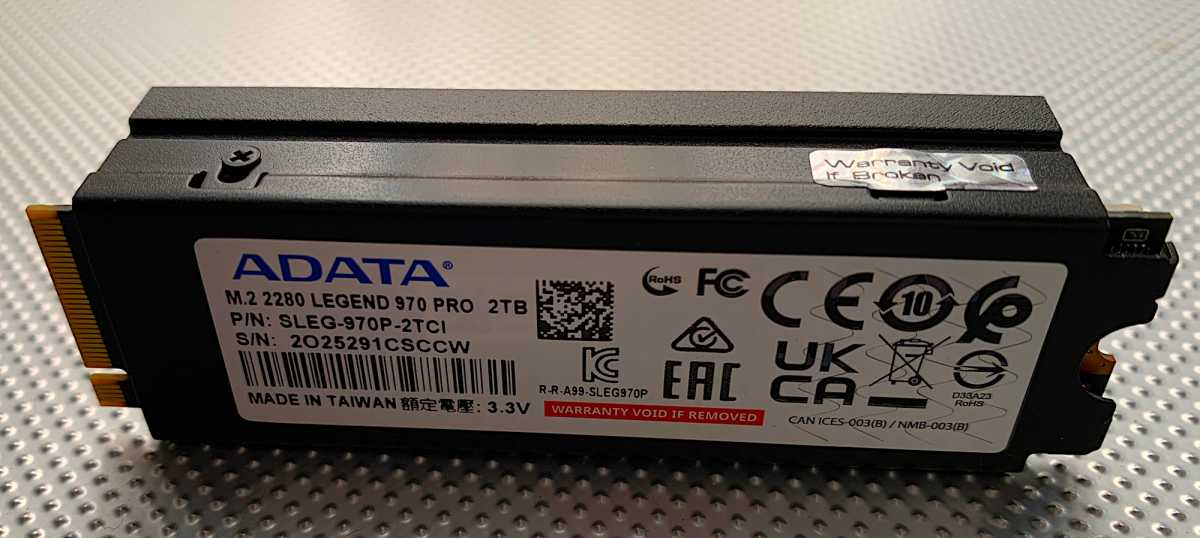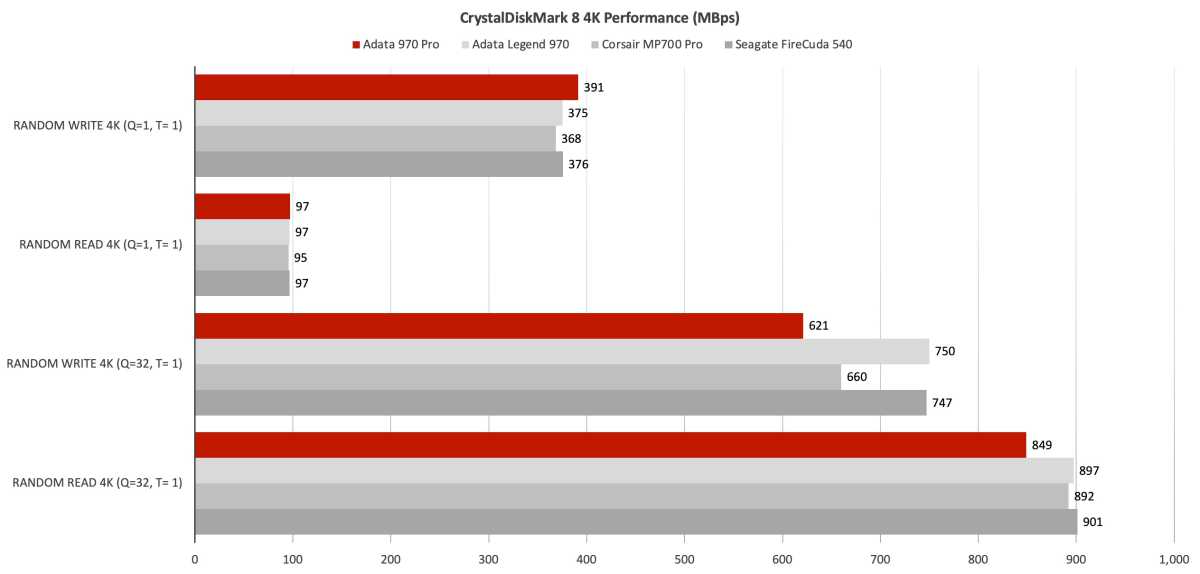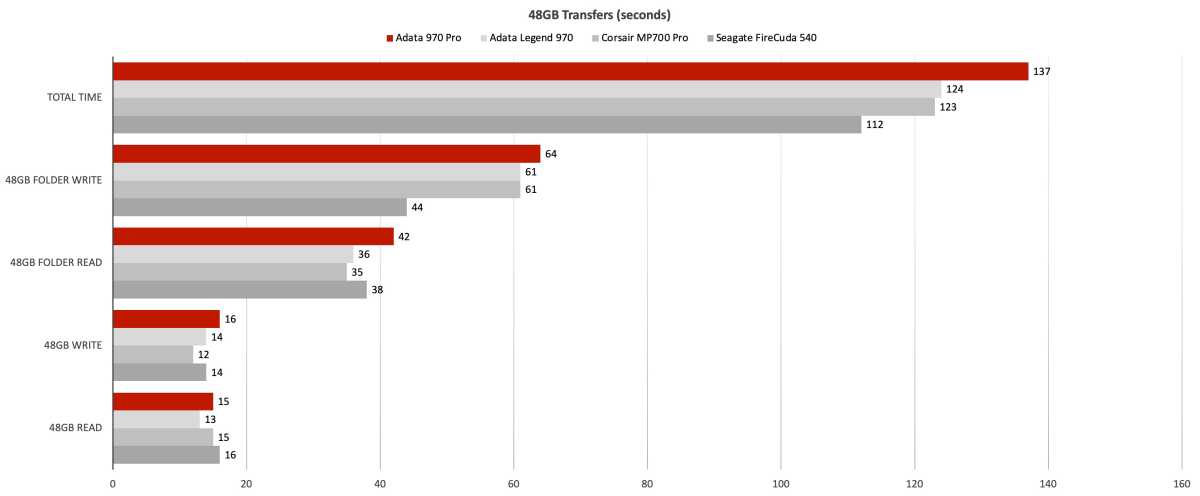- Регистрация
- 17 Февраль 2018
- Сообщения
- 22 702
- Лучшие ответы
- 0
- Баллы
- 2 093
Offline
At a glance
Expert's Rating
Pros
The Adata 970 Pro set a performance record writing 450GB, but was middling (for a PCIe 5.0 DRAM design) in other tests. We love its fan-cooled heatsink and the overall design, which will appeal to gamers.
Best Prices Today: Adata 970 Pro NVMe SSD
Retailer
Price
Adata
$299.99
View Deal
Price comparison from over 24,000 stores worldwide
Product
Price
Price comparison from Backmarket
Adata makes very competitive SSDs, such as the Adata 970 I reviewed last fall. The drive maker stays that course with 970 Pro, while straying from the norm in a couple key ways.
This SSD’s test results were a generally excellent-yet-mixed bag — it aced the 450GB write and multiple-queue CrystalDiskMark 8 tests, but slowed during the 48GB transfers and single-queue exams.
What are the 970 Pro’s features?
The 970 Pro is your standard 2280, NVMe M.2 PCIe 5.0 SSD. One way it varies from the norm, and presumably earns its “Pro” moniker, is with its large heatsink cooled by a fan. You can see the power connector for the fan, as well as the rather beefy heatsink in the image below.

The 970 Pro also differs from the no-Pro 970 by using an InnoGrit IG5666 controller (as opposed to a Phison PS5026 E26) and 232-layer TLC NAND. Like the straight 970, it’s a DRAM design, meaning the secondary cache is on-drive, as opposed to the drive using your system’s DRAM for cache, as in a Host Memory Buffer (HMB) design. The distinction is notable in the 970 Pro’s comparatively fast random performance numbers. (HMB designs are very fast with large sequential transfers, but slow with random ops).
Adata’s warranty on the 970 Pro is for five years, abridged by a 740TB per 1TB of capacity TBW (terabytes that my be written) rating. 740TBW is a generous step up from the 600TBW per 1TB of capacity we see with most drives.
How much does the 970 Pro cost?
The 2TB 970 Pro we tested costs $299.99 on Adata’s site (it’s not yet available on Amazon). There will be 1TB and 4TB versions as well, but prices for those have not been announced.

How fast is the 970 Pro?
Overall, the 970 Pro was very quick, but the performance was also somewhat uneven. It was a bit slow (for Gen 5) with the 48GB files and hell on wheels with the 450GB file write; mediocre for PCIe 5.0 with single queues, and top-notch when multiple queues were in play. That’s a bit odd as the 450GB write test, which the drive aced, is a single-queue operation.
Also, I didn’t quite see the 14GBps that Adata advertises, though the word through the grapevine is that the very latest Intel systems might just deliver that kind of performance.

Multiple-queue performance is where the 970 Pro really shines With a single queue-, not so much.
Multiple-queue performance is where the 970 Pro really shines With a single queue-, not so much.
Multiple-queue performance is where the 970 Pro really shines With a single queue-, not so much.
The 970 Pro’s CrystalDiskMark 8 random performance maintained greater equilibrium — on par with the Legend 970, Corsair MP700 Pro, and Seagate FireCuda 540 PCIe 5 competition. In other words, 4K performance was fast both with queues and without.

The 970 Pro’s random performance was more balanced, good both with queues and without.
The 970 Pro’s random performance was more balanced, good both with queues and without.
The 970 Pro’s random performance was more balanced, good both with queues and without.
While the 970 Pro wasn’t slow in our 48GB transfers, there are a lot of drives that are faster. Including some host memory buffer (HMB/DRAM-less) drives.

While the 970 Pro wasn’t slow in our 48GB transfers, there are a lot of drives that are faster.
While the 970 Pro wasn’t slow in our 48GB transfers, there are a lot of drives that are faster.
While the 970 Pro wasn’t slow in our 48GB transfers, there are a lot of drives that are faster.
On the other hand, the 970 Pro was the fastest 450GB write time I had seen at the time of testing, though one SSD has surpassed it since. Regardless, you can hardly complain about 2 minutes, 13 seconds.

This is among the fastest 450GB write time I’ve seen.
This is among the fastest 450GB write time I’ve seen.
This is among the fastest 450GB write time I’ve seen.
Overall, the 970 Pro delivers very good performance. Especially when a lot of data is being written sequentially. However, it’s merely middle of the top-shelf pack in many areas.
Should you buy the Adata 970 Pro?
The Adata 970 Pro is a great drive, but it’s competing against similarly priced SSDs that are also great, and even better. Keep in mind that heatsinks generally raise the price of an SSD, so if you don’t need one (many motherboards have their own), you can save a few bucks on an alternative purchase.
How we test
Drive tests currently utilize Windows 11, 64-bit running on an X790 (PCIe 4.0/5.0) motherboard/i5-12400 CPU combo with two Kingston Fury 32GB DDR5 4800MHz modules (64GB of memory total). Both 20Gbps USB and Thunderbolt 4 are integrated to the back panel and Intel CPU/GPU graphics are used. The 48GB transfer tests utilize an ImDisk RAM disk taking up 58GB of the 64GB of total memory. The 450GB file is transferred from a 2TB Samsung 990 Pro which also runs the OS.
Each test is performed on a newly formatted and TRIM’d drive so the results are optimal. Note that in normal use, as a drive fills up, performance may decrease due to less NAND for secondary caching, as well as other factors. This can be less of a factor with the current crop of SSDs with far faster late-generation NAND.
Caveat: The performance numbers shown apply only to the drive we were shipped and to the capacity tested. SSD performance can and will vary by capacity due to more or fewer chips to shotgun reads/writes across and the amount of NAND available for secondary caching. Vendors also occasionally swap components. If you ever notice a large discrepancy between the performance you experience and that which we report, by all means, let us know.
Expert's Rating
Pros
- Fastest ever writing our 450GB file
- Fan-cooled heatsink
- DRAM cache for fast random performance
- Pricey
- Middling single-queue benchmark numbers for a DRAM design
The Adata 970 Pro set a performance record writing 450GB, but was middling (for a PCIe 5.0 DRAM design) in other tests. We love its fan-cooled heatsink and the overall design, which will appeal to gamers.
Best Prices Today: Adata 970 Pro NVMe SSD
Retailer
Price
Adata
$299.99
View Deal
Price comparison from over 24,000 stores worldwide
Product
Price
Price comparison from Backmarket
Adata makes very competitive SSDs, such as the Adata 970 I reviewed last fall. The drive maker stays that course with 970 Pro, while straying from the norm in a couple key ways.
This SSD’s test results were a generally excellent-yet-mixed bag — it aced the 450GB write and multiple-queue CrystalDiskMark 8 tests, but slowed during the 48GB transfers and single-queue exams.
What are the 970 Pro’s features?
The 970 Pro is your standard 2280, NVMe M.2 PCIe 5.0 SSD. One way it varies from the norm, and presumably earns its “Pro” moniker, is with its large heatsink cooled by a fan. You can see the power connector for the fan, as well as the rather beefy heatsink in the image below.

The 970 Pro also differs from the no-Pro 970 by using an InnoGrit IG5666 controller (as opposed to a Phison PS5026 E26) and 232-layer TLC NAND. Like the straight 970, it’s a DRAM design, meaning the secondary cache is on-drive, as opposed to the drive using your system’s DRAM for cache, as in a Host Memory Buffer (HMB) design. The distinction is notable in the 970 Pro’s comparatively fast random performance numbers. (HMB designs are very fast with large sequential transfers, but slow with random ops).
Adata’s warranty on the 970 Pro is for five years, abridged by a 740TB per 1TB of capacity TBW (terabytes that my be written) rating. 740TBW is a generous step up from the 600TBW per 1TB of capacity we see with most drives.
How much does the 970 Pro cost?
The 2TB 970 Pro we tested costs $299.99 on Adata’s site (it’s not yet available on Amazon). There will be 1TB and 4TB versions as well, but prices for those have not been announced.

How fast is the 970 Pro?
Overall, the 970 Pro was very quick, but the performance was also somewhat uneven. It was a bit slow (for Gen 5) with the 48GB files and hell on wheels with the 450GB file write; mediocre for PCIe 5.0 with single queues, and top-notch when multiple queues were in play. That’s a bit odd as the 450GB write test, which the drive aced, is a single-queue operation.
Also, I didn’t quite see the 14GBps that Adata advertises, though the word through the grapevine is that the very latest Intel systems might just deliver that kind of performance.

Multiple-queue performance is where the 970 Pro really shines With a single queue-, not so much.
Multiple-queue performance is where the 970 Pro really shines With a single queue-, not so much.
Multiple-queue performance is where the 970 Pro really shines With a single queue-, not so much.
The 970 Pro’s CrystalDiskMark 8 random performance maintained greater equilibrium — on par with the Legend 970, Corsair MP700 Pro, and Seagate FireCuda 540 PCIe 5 competition. In other words, 4K performance was fast both with queues and without.

The 970 Pro’s random performance was more balanced, good both with queues and without.
The 970 Pro’s random performance was more balanced, good both with queues and without.
The 970 Pro’s random performance was more balanced, good both with queues and without.
While the 970 Pro wasn’t slow in our 48GB transfers, there are a lot of drives that are faster. Including some host memory buffer (HMB/DRAM-less) drives.

While the 970 Pro wasn’t slow in our 48GB transfers, there are a lot of drives that are faster.
While the 970 Pro wasn’t slow in our 48GB transfers, there are a lot of drives that are faster.
While the 970 Pro wasn’t slow in our 48GB transfers, there are a lot of drives that are faster.
On the other hand, the 970 Pro was the fastest 450GB write time I had seen at the time of testing, though one SSD has surpassed it since. Regardless, you can hardly complain about 2 minutes, 13 seconds.

This is among the fastest 450GB write time I’ve seen.
This is among the fastest 450GB write time I’ve seen.
This is among the fastest 450GB write time I’ve seen.
Overall, the 970 Pro delivers very good performance. Especially when a lot of data is being written sequentially. However, it’s merely middle of the top-shelf pack in many areas.
Should you buy the Adata 970 Pro?
The Adata 970 Pro is a great drive, but it’s competing against similarly priced SSDs that are also great, and even better. Keep in mind that heatsinks generally raise the price of an SSD, so if you don’t need one (many motherboards have their own), you can save a few bucks on an alternative purchase.
How we test
Drive tests currently utilize Windows 11, 64-bit running on an X790 (PCIe 4.0/5.0) motherboard/i5-12400 CPU combo with two Kingston Fury 32GB DDR5 4800MHz modules (64GB of memory total). Both 20Gbps USB and Thunderbolt 4 are integrated to the back panel and Intel CPU/GPU graphics are used. The 48GB transfer tests utilize an ImDisk RAM disk taking up 58GB of the 64GB of total memory. The 450GB file is transferred from a 2TB Samsung 990 Pro which also runs the OS.
Each test is performed on a newly formatted and TRIM’d drive so the results are optimal. Note that in normal use, as a drive fills up, performance may decrease due to less NAND for secondary caching, as well as other factors. This can be less of a factor with the current crop of SSDs with far faster late-generation NAND.
Caveat: The performance numbers shown apply only to the drive we were shipped and to the capacity tested. SSD performance can and will vary by capacity due to more or fewer chips to shotgun reads/writes across and the amount of NAND available for secondary caching. Vendors also occasionally swap components. If you ever notice a large discrepancy between the performance you experience and that which we report, by all means, let us know.
